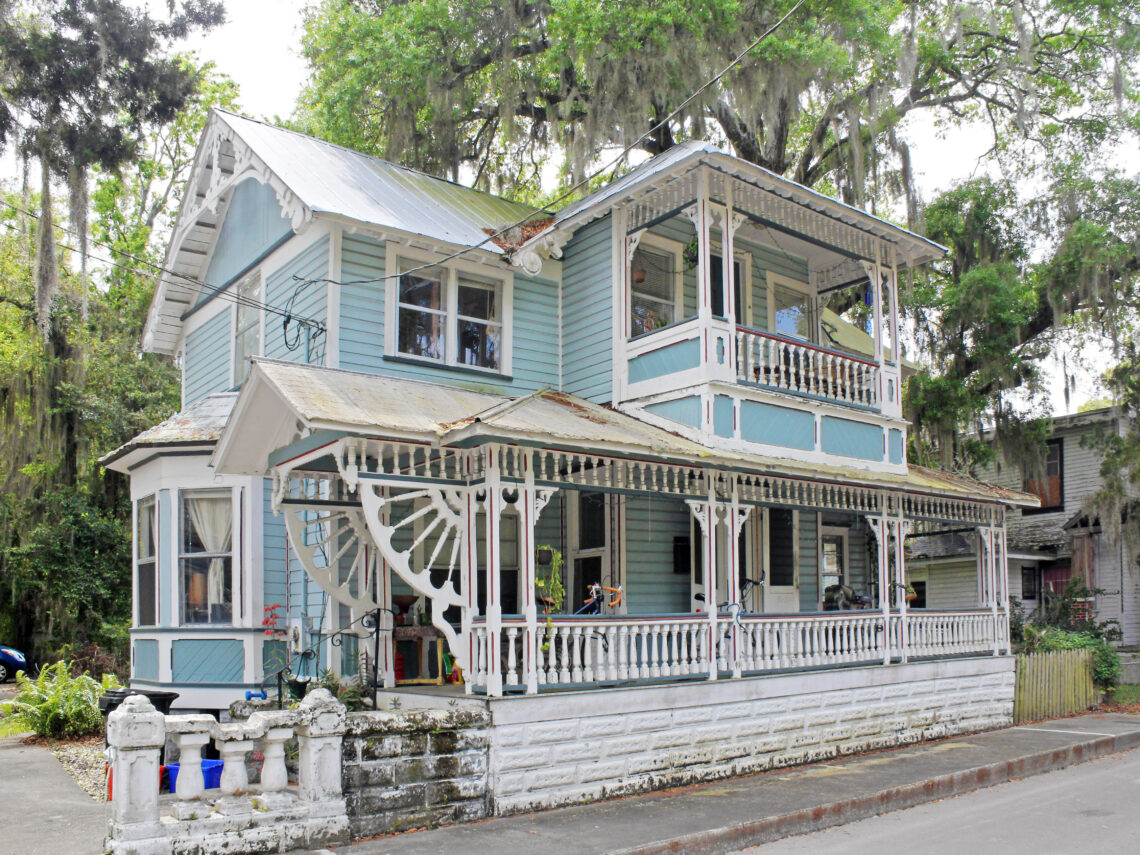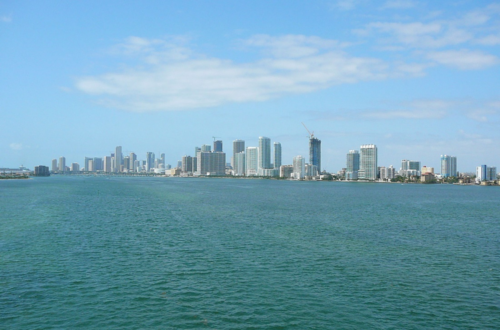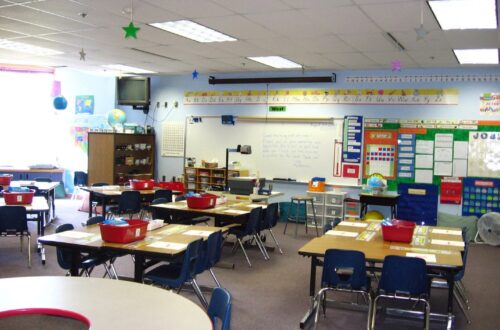Big house, big lawn, big driveway—or nothing at all.
That’s Gainesville’s message to anyone who wants to make the city their home. In most of Gainesville’s residential areas, strict “minimum lot size” requirements make it illegal to build anything but a stand-alone house on a giant plot of land.
How much land, exactly? The median new house in the United States is constructed on 0.18 acres of land, with the house itself occupying less than a third of that space. In Gainesville, building a home on an empty 0.18-acre lot—the standard American practice—is prohibited on most of the land set aside for housing.
But this understates how extreme Gainesville’s minimum lot size policies are. In about 70% of Gainesville neighborhoods designated for single-family homes, new houses must sit on at least 0.28 acres of land, a lot size that’s 55% larger than the national median.
To put things in standard American English: On a plot of land the size of a football field, Gainesville’s rules wouldn’t allow five houses to be built.
Requiring renters and homeowners to occupy so much land is a choice that makes housing less affordable for everyone. It’s a choice that excludes new neighbors, reinforcing legacies of segregation. And it’s a choice that makes residents less free to live the way they want.
A crisis of prices
In 2016, the average Gainesville home sold for $274,734. Today, that number is $436,892.
The rental market is no better. In the past three years, Gainesville’s rent prices have increased by more than 20%, costing the average renter almost $4,000 more per year.
The reasons for this surge in Gainesville’s cost of living are intuitive to anyone who has taken an introductory economics class: People want to live in Gainesville, but there’s not enough housing supply to meet demand. Small, affordable starter homes are increasingly scarce.
Given Gainesville’s housing policies, that’s no surprise. Researchers at Harvard’s Kennedy School of Government found that in the housing sector, minimum lot size requirements restrict supply and raise prices more than any other cause.
Another study concluded that imposing strict minimum lot size requirements to part of a neighborhood adds about $30,000 to its average home prices.
Conversely, cities that have reduced or eliminated minimum lot sizes have significantly increased housing affordability. Houston’s decision to shrink its minimum lot sizes by two-thirds ushered in a boom of new housing, particularly in the form of townhomes. Today, the rent in Houston is 23% lower than the national average. It’s also lower than Gainesville’s average rent three years ago.
Again, this abundance of evidence confirms common sense. Requiring homeowners to buy land they don’t want only forces them to pay more and maintaining acres upon acres where new homes can’t be built only limits housing supply and opportunity.
The result is the same for everyone: Higher prices and tighter budgets. So, why do these policies exist?
A legacy of exclusion
Higher prices are the point.
When Gainesville instituted its minimum lot size policy in 1958, other American cities were doing the same. Explicitly or implicitly, they aimed to control who could live in their rapidly expanding suburbs: Wealthy, white residents welcome. Anyone else, stay out.
Minimum lot sizes were convenient ways to push a vision of segregation. Anyone who wanted a home now had to pay for a large plot of land along with their house, keeping suburban housing out of reach for those who couldn’t afford this extra cost.
That drove out young, low-income families whose children would “burden” the local education system, as well as racial minorities suffering from extreme rates of poverty.
Gainesville’s minimum lot size policies continue to achieve their original exclusionary purposes. The city’s nonwhite residents are less likely to live in single family homes, which are overwhelmingly zoned in areas with high minimum lot size requirements.
A report commissioned by the City of Gainesville found that while people of color are disproportionately more likely to rent rather than own their homes, the “average rental unit is currently only affordable to the typical white or homeowner household in Gainesville.”
An absence of affordable housing options segregates disadvantaged residents into undesirable areas. In Alachua County, where Black residents have the lowest incomes and largest families, Black children are heavily concentrated in the areas containing the worst-performing public schools, which lack the resources of schools surrounded by high property values. The county’s Black families “occupy the smallest and oldest homes of the poorest quality and lowest property valuation.”
The causes of this inequality are wide-ranging, but minimum lot sizes unmistakably contribute to the problem.
That means minimizing them can be part of the solution: In one study of the Boston metro area, Harvard researchers determined that neighborhoods become more racially diverse for each additional housing unit allowed per acre of land.
It’s doubtful that many of Gainesville’s current homeowners in exclusionary neighborhoods are racists seeking to shove out neighbors who don’t look like them. But there’s a reason these policies are still in place after more than 70 years of harm. Higher prices are still the point.
Thanks to cultural pressures and favorable government incentives, Americans treat homeownership primarily as an investment. The problem with this attitude is that it incentivizes restricting housing opportunities so that home prices balloon unsustainably.
That’s the only way to justify a home purchase as a halfway-decent investment.
It isn’t the fault of homeowners who have sunk most of their wealth into a mortgage that they’ve been sold an ideal of ever-increasing property values. But that untenable expectation can’t be allowed to keep housing forever out of reach for those who can’t afford it.
There are some indications that allowing more housing to be built on less land could ultimately benefit homeowners by enabling them to sell land they don’t want, land which also becomes more valuable simply because it can now be put to use. At the same time as rising demand for land might benefit existing homeowners, increasing the housing supply significantly lowers rent for everyone else.
Still, this may not be enough to persuade some homeowners to allow more people and housing in their neighborhoods. Certain policies could provide homeowners with confidence that the house they thought was a good investment stays that way. These might include proposals such as the provision of home equity insurance that locks in existing home values or “tax increment local transfers” which grant a share of new tax revenue from land development to property owners in the neighborhood.
Though we should try to make transitions in housing policy easier for homeowners, it’s important to remember that those who most urgently need something to change are those who can’t afford homes in the first place. Poor households spend a greater portion of their income on housing than their wealthier counterparts. For that sacrifice, they’re confined to crumbling, cramped buildings in underinvested communities.
If we want to erase the lines dividing our neighborhoods by class and race, allowing affordable homes to be built on less land is a good start.
A future of freedom
Gainesville’s housing regulations promote a narrow version of the American Dream—one where the whole point of existing in America is to own a big patch of land and a house—but even those who can afford to live this dream may not want to.
The city’s stringent barriers against diverse housing options make it hard not to wonder whether these rules are designed to recreate an idealized image from a 1950s advertisement. (Your picket fence, dog and 2.5 children are not included.)
I’ve lived in all sorts of housing throughout my life, from single-family homes to townhouses, apartments and dorms. In each case, my housing situation has been what made the most sense for me and my family. As a young person soon to graduate from college, I’m not looking to settle into a large, expensive house with a well-manicured suburban lawn (at least not for another decade or two). Smaller, denser and more affordable housing options fit more comfortably into my personal American Dream.
Everyone else should also have the freedom to live the way they choose. Along with freedom of housing opportunity, this includes freedom from car dependence and freedom from filthy air. With homes sprawled across vast plots, those on the city’s outskirts can’t get anywhere without a long drive, increasing traffic and degrading our environment.
By now, it’s clear that we need a plan to reduce Gainesville’s minimum lot sizes. Thankfully, one exists. Gainesville City Commissioner Brian Eastman has proposed reducing minimum lot sizes to 0.083 acres in neighborhoods zoned for single-family homes.
That’s the same lot size required in charming residential areas such as Pleasant Street and Duckpond, which were largely built before Gainesville’s exclusionary housing policies were enacted.
On Sept. 19, 2024, the city commission will take an implementation vote on Eastman’s proposal. Anyone can follow these instructions to speak up against minimum lot sizes before the vote.
Given how few people show up to share their opinions in local forums, your voice can make a meaningful difference. Although engaging on this issue might earn you the label of a local politics nerd, it also places you at the forefront of change—pushing us beyond the constraints of a tainted past and toward a future where Gainesville is for people, not for land.
That’s a world we can all live in.
Check out other recent articles from the Florida Political Review here.





